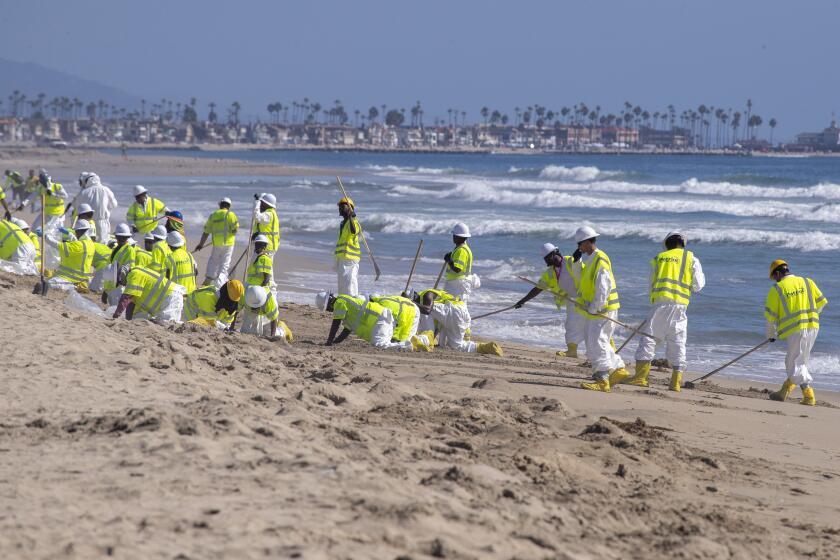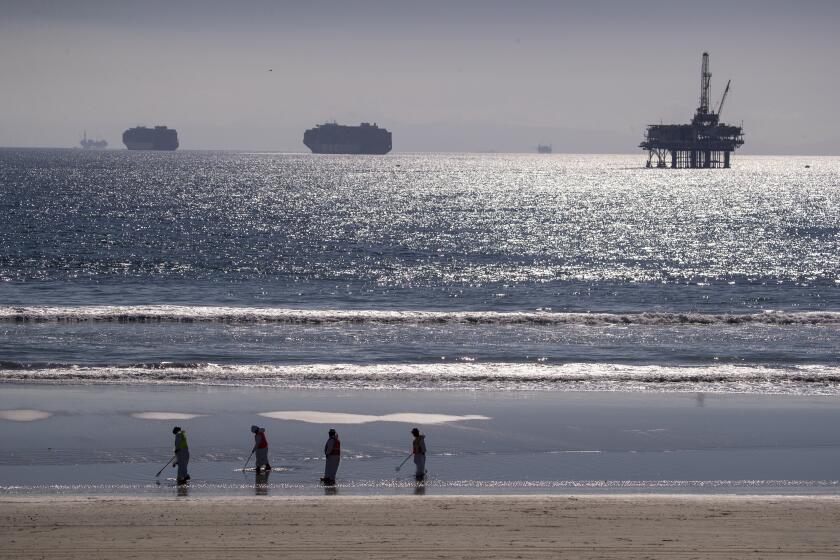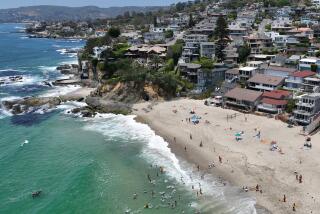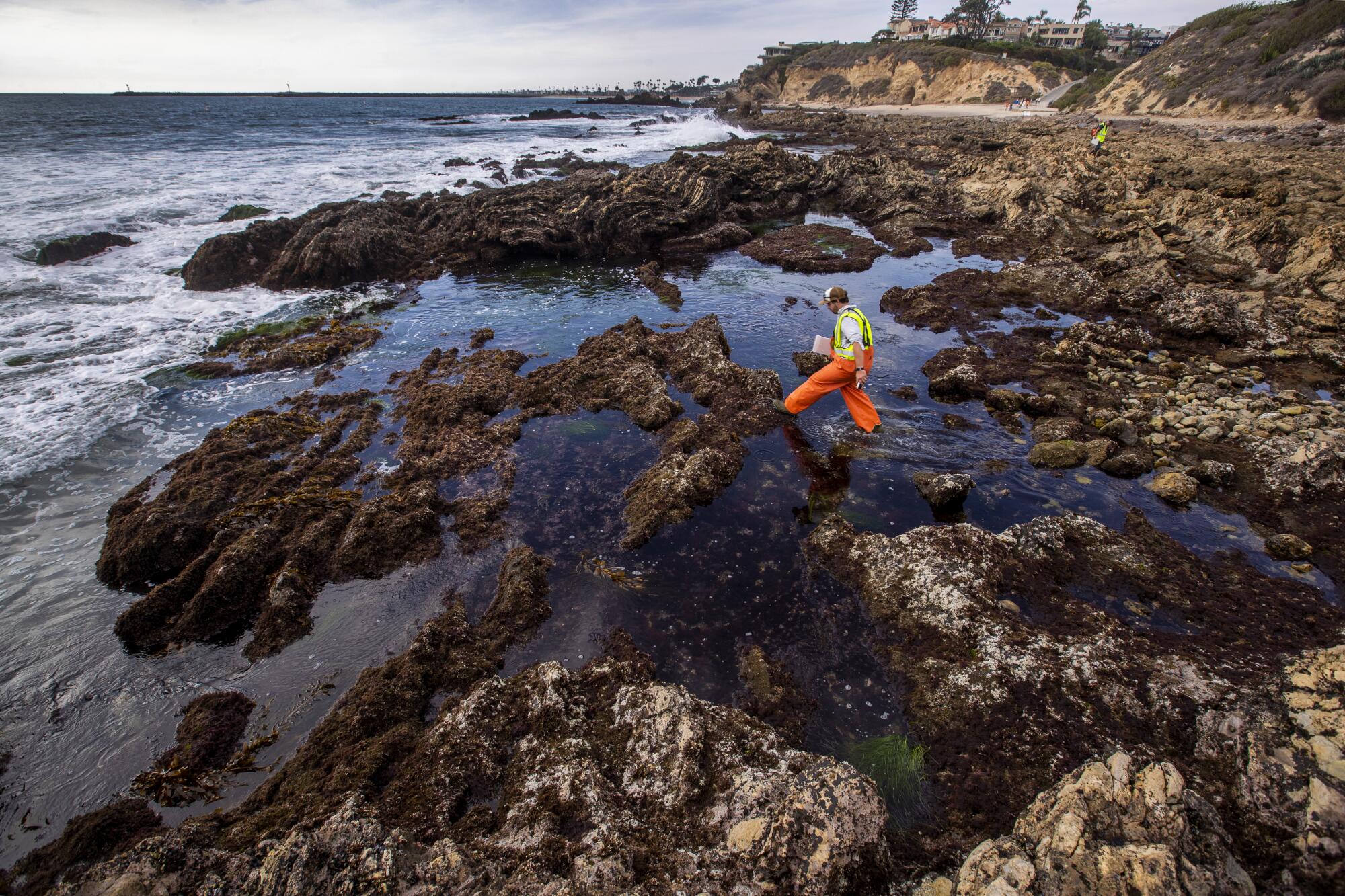
The hills glowed as the sun fell. The light glinted off the kelp beds, roused the shorebirds and turned the waves translucent green before they crashed and chased the sandpipers up the beach. It was an everyday scene here that felt strikingly removed from modern times.
Even as one of the uglier aspects of modern times encroached.
The miles-wide oil slick from the spill reported Saturday off Huntington Beach had already befouled beaches and estuaries just to the north. Now it was drifting off one of the most treasured stretches of the California coast – the coves of Laguna Beach.
“It’s just beyond sad,” said Clayton Elder, 32, who walked from his apartment out to the bluff over Crescent Bay to see if the oil had arrived.
The Oklahoma native moved to Laguna Beach six years ago while getting his doctorate in earth systems science at UC Irvine. He still marvels that such a place exists and teases his neighbors who are lifelong residents for not fully appreciating what they have.
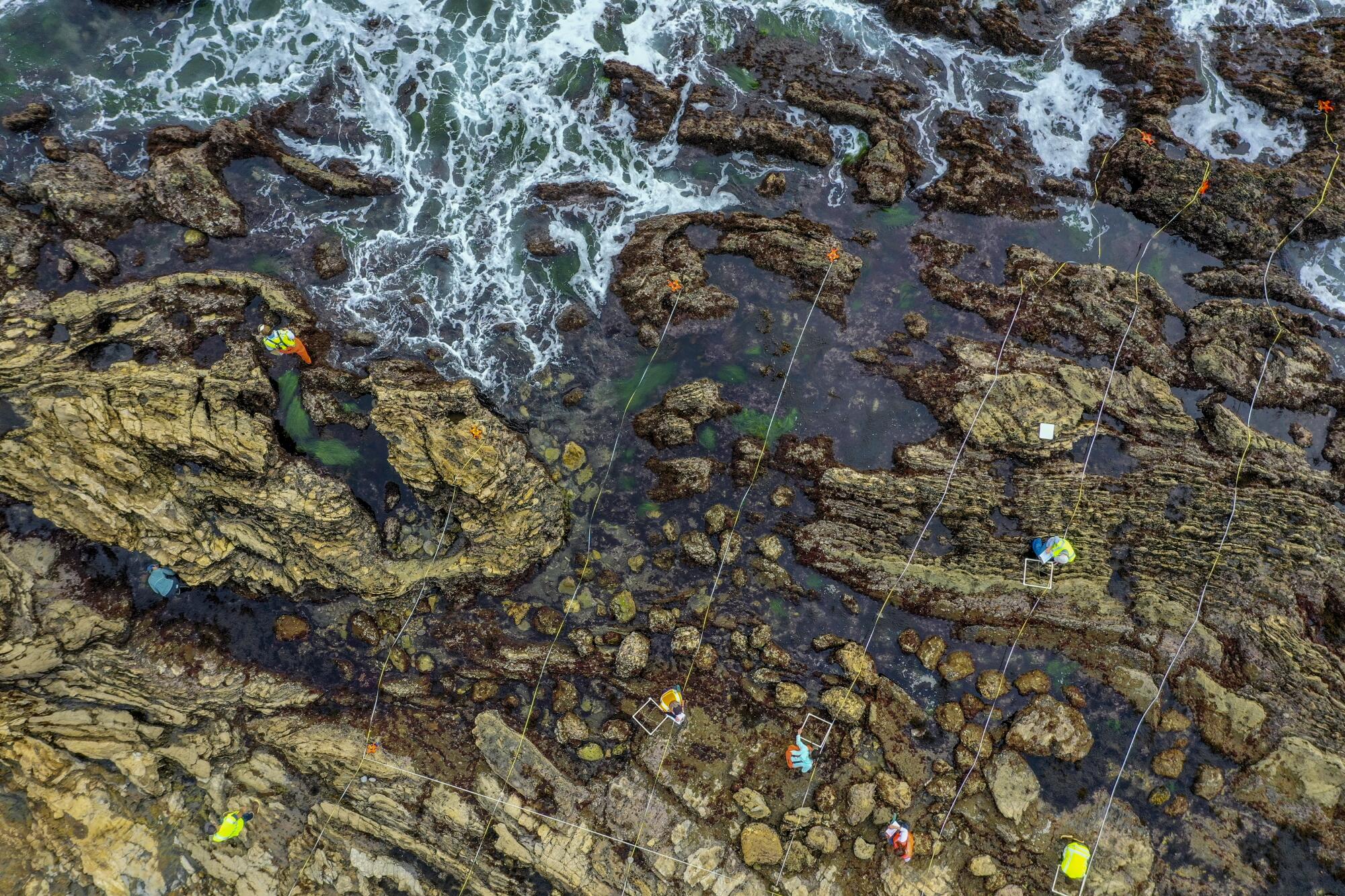
“I snorkel here all the time,” he said. “It’s my backyard really. There’s a kelp forest off this point. I see Garibaldi, sheepshead and calico bass. You see schools of anchovy as big as a bus right underneath you. It’s amazing to live next to this still pretty pristine ecosystem, especially close to a big city like L.A.”
The quintessence of California’s shoreline is its stark variety, from the gentle beaches of Coronado to the sea stacks of the North Coast. Laguna is one of the inarguable wonders. Its hills plummet into the sea like the Cote d’Azur, creating a scalloped seascape of caves, cracks and arches, of blowholes, tide pools and white-sand beaches that are all as enchanting in their complexity as they are vulnerable.
While only small bits of oil had washed onto several beaches in the area so far, officials warned that the shifting currents could still push thicker parts of the slick ashore. Scientists say that could be devastating for some of the richest marine ecosystems in California.
Even if the area dodges a disaster, the specter of future ones persists because these ancient habitats remain so close to sprawling oil infrastructure and one of the busiest shipping channels in the world.
A massive oil spill off the Orange County coast has fouled beaches and killed birds and marine life
The San Joaquin Hills created this rugged seaside topography stretching from the Newport Harbor entrance to Dana Point, an area long famous to painters around the world for the way the warm California light fell on its hillsides, rocky points and quiet coves.
That entire 13 miles of coast falls into four marine protected areas, which has allowed all sorts of sea and shorebird life to flourish from the deep kelp forests to the tide pools and sand: moray eels, limpets, sea cucumbers, anemones, sea stars, octopus, mussels, sculpin, giant sea bass, seals, sea otters, cormorants, egrets and great blue herons.
“The coastline there is just teeming with life,” said Matthew Bracken, professor of ecology and evolutionary biology at UC Irvine. “There are things you just don’t find in other places. There aren’t many places where I go out on the shoreline and I’m reasonably likely to find an octopus or I can see sea hares in the tide pools.”
One of the key species making a comeback after decades of overharvesting: the California spiny lobster.
“You don’t see them elsewhere because people are taking them,” said Bracken. “Spiny lobsters are known to be what are called keystone species; they organize the entire system. They eat things that would otherwise outcompete other organisms. They promote diversity. So by establishing a reserve where you can have spiny lobster present, then that actually has ripple effects throughout the entire system.”
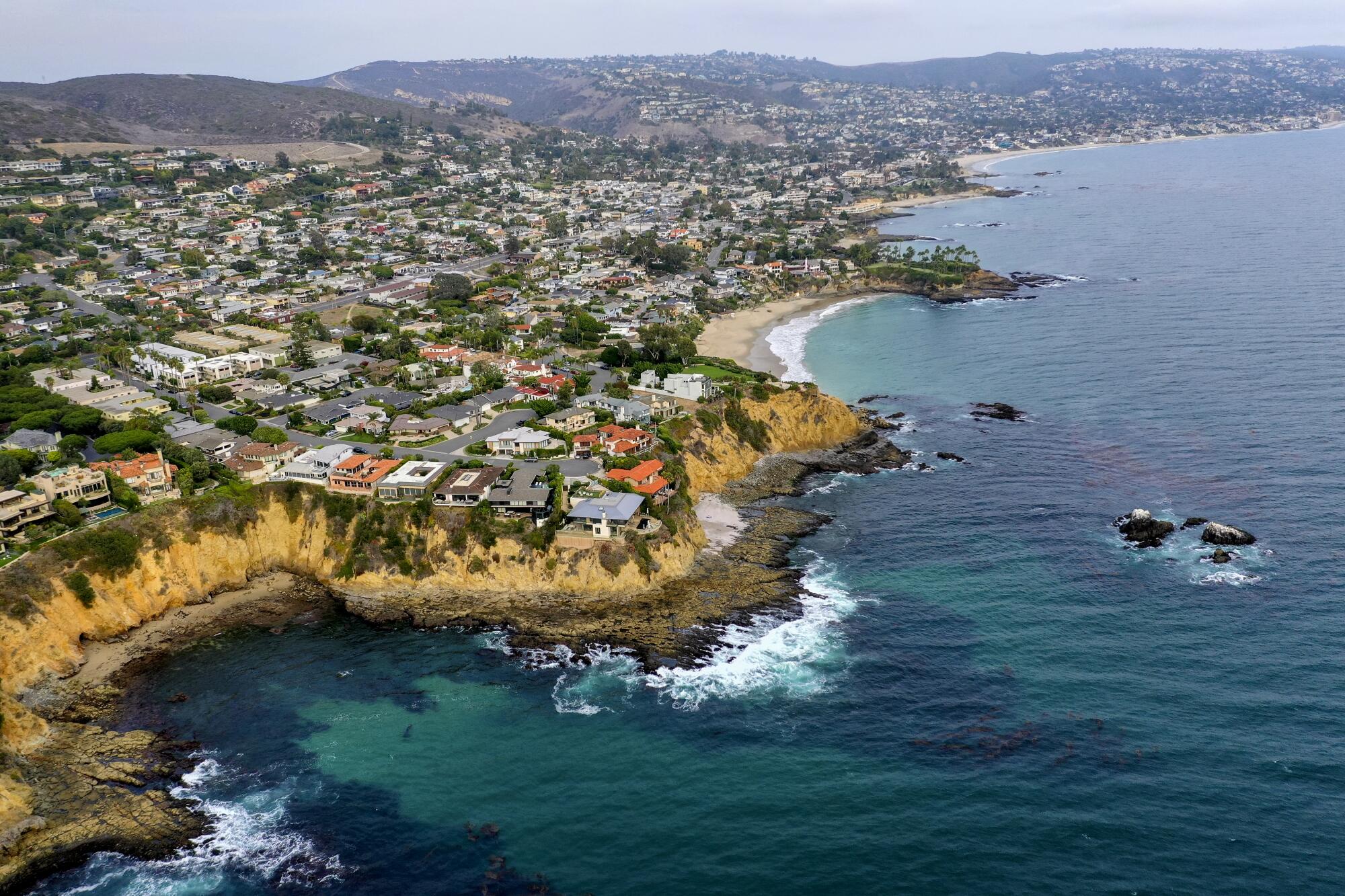
Scientists say the rocky topography underwater and in the tidal zone of Laguna — all those fissures, ledges and holes — create microhabitats for hundreds of creatures. But it is that very complexity that would be extremely difficult to clean if it were fouled by oil.
When an oil pipeline ruptured near Refugio Beach in Santa Barbara County in 2015, the crude spilled onto both sand and rocky shoreline. Kristen Hislop, marine conservation director for the Environmental Defense Center, said crews on the sand could just scoop up the toxic goop and take it away.
“On the rocks, they actually had to scrape everything by hand,” she said. “Obviously that’s a lot more difficult. Subtidal areas present even greater challenges.”
B. Claire Arre recalls monitoring that cleanup in her role as education and program director of the conservation group Laguna Ocean Foundation.
“To watch barnacles just disappear because they’re covered in oil, it’s watching a slow death of things that you care about, that help filter our water, that help keep our shoreline beautiful,” she said. “It’s devastating. They are still working on the restoration of that oil spill six years later.”
The Coast Guard investigates a cargo vessel that was in the area before a pipeline break off the Orange County coast spilled 144,000 gallons of oil.
Her group was about to launch a restoration project for the olive rockweed, a species endemic to Laguna found nowhere else south of Santa Barbara. Since Saturday evening, she has been waiting anxiously to see if existing seaweed and kelp would be overrun by the oil.
On Wednesday, she was feeling slightly more upbeat that the slick largely remained offshore, where Coast Guard cleanup boats were corralling it. But even if Laguna escapes this spill, “it’s always an impending threat.”
And as with the rest of the coast, it’s a threat to the economy as well. Laguna’s beauty has been its lure since the plein air artists established a colony here in the late 1800s. In recent decades, multimillionaires and plenty of billionaires have been pushing the potters and painters out. A home on one of the city’s 35 coves might sell for $20 million or more. Millions of visitors flood the streets in summer to swim, play and see the art festivals, packing expensive restaurants and hotels. Resorts like the Montage Laguna Beach are destinations for luxury weddings.
While all this high-end development has certainly changed the bohemian vibe of Laguna, it hasn’t subsumed it. There are still plenty of old shingled cottages and Spanish bungalows, funky art and earthy souls.
Karen Garman, 65, is a drumming and musical theater instructor for children.
“This is my church, coming down and taking swim,” she said, above Crescent Bay. “Over there, that’s where I collect sea glass. There’s a little seal that lives here. I call him Sammy.”
She has been checking the turquoise water multiple times a day to look for oil, praying her church would survive, and so far relieved. “It’s been gorgeous,” she said.
Wedding photographer Eliseo Valdovinos drove four hours from Bakersfield this week to shoot a couple next to the famed “Pirates Tower” on Victoria Beach. The bride had seen photos of it on Pinterest. The tower is an enclosed staircase that looks like a slightly askew ancient lighthouse, built in 1926 so a homeowner could get down the cliff. It’s been a draw for painters and photographers ever since.
Police tape blocked access to the beach due to the spill. Valdovinos looked at his partner. “We’re here, what do we do? We can’t just drive back.”
He grabbed his gear, and the group of four walked under the tape and headed across the sand. A lifeguard stopped them and told them they had to leave, but seemed tentative enough in his warning. When he turned his back, they bolted for the tower, just as it started to rain and thunder. They only stayed a few minutes, but Valdovinos was impressed enough to put it on his list of romantic spots for future shoots. “I’ll definitely be back here.”
Rick Delanty, 70, has been painting this coast for 50 years and never struggles to find something new in what he calls a “wonderland of light.” He relishes the riot of foliage climbing the cliffs, the lights on the hills of South Laguna at night. “There’s a timelessness to it all.”
A member of the Laguna Plein Air Painters Assn., Delanty is working on the bluffs this week, with the beaches closed, painting four works for the group’s annual invitational. He says artists past and present imbued the city with a conservationist spirit.
“Artists are all about preservation: preservation of the moment, preservation of the environment,” he said.
He hopes the oil spill will strengthen that resolve, not just in Laguna, but along the entire coast.
More to Read
Sign up for Essential California
The most important California stories and recommendations in your inbox every morning.
You may occasionally receive promotional content from the Los Angeles Times.
